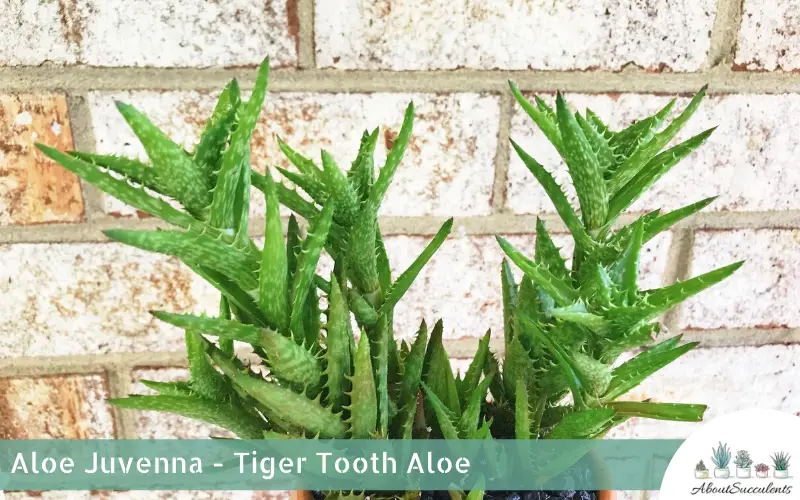
Aloe juvenna is a miniature succulent with a fascinating look. It carries the bright-green color that is associated with aloes but is embedded with peculiar white spots.
Aloe juvenna grows spiked leaves – often described as small teeth – that stack and form an interesting rosette. The spikes may look sharp and resemble a Tiger’s jaw but they will not prick when touched.
Collectively, the small rosettes give the plant a fuzzy appearance when viewed from a distance.
When Aloe juvenna is given enough exposure to the sun in the summer months, the bright-green leaves assume a reddish-brown color.
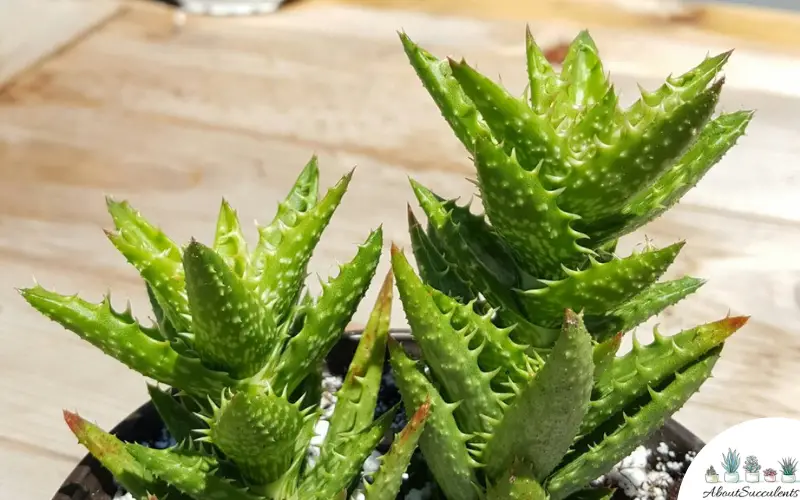
Tiger Tooth Aloe is the popular alias assigned to Aloe juvenna because of its spiky leaves. It can grow up to 12-inches (30.5cm) tall and 24-inches (61cm) wide which makes the succulent an ideal ground cover.
Tiger Tooth Aloe originates from the Aloaceae family and is native to Kenya.
General Information:
Also known as: Tiger Tooth Aloe
Plant Family: Aloeceae
Origin: Kenya
Height: 12-inches (30.5cm)
Exposure: Full to partial sunlight up to 6 hours per day
Water Needs: Water only when soil is dry to the touch, little watering during the winter months.
Soil Type: Sandy or cactus soil mixed with perlite at a 2:1 ratio.
Soil pH: Neutral (7.0 to 8.5 pH)
Tolerance: Drought
How to Grow and Care for Aloe Juvenna
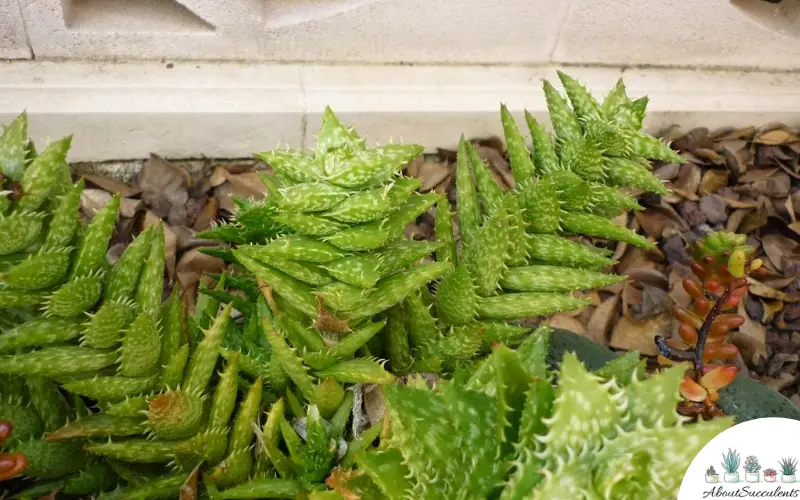
Aloe juvenna is a resilient succulent that can grow properly in both warm and dry climates. It is not a cold-hardy plant. If you live in a region where temperatures drop below 20° F (-6.7° C), it would be best to grow the plant indoors.
1. Sunlight
Aloe juvenna can thrive indoors and outdoors as long as it receives enough sunlight. Tiger Tooth Aloe can grow with partial share to fun sun exposure.
For best results, plant Tiger Tooth Aloe in the outdoors where it can receive sunlight consistently and achieve the reddish-brown color that has delighted many succulent hobbyists.
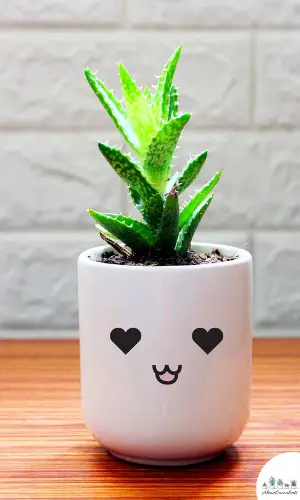
If you want to have Aloe juvenna as an outdoor plant; probably as ground cover, put it in an area that received 6 hours of morning sunlight per day. Morning sun is advisable because the afternoon sun might get too intense and cause sunburn to Aloe juvenna.
If you want to have Aloe juvenna indoors, look for a window facing the east. South and west-facing windows will do. Make sure the plant gets partial sun when grown indoors.
During the dark, winter months you may want to get a Grow Light to give Aloe juvenna its daily dose of sunlight.
2. Watering
Aloe juvenna has the same watering needs as other varieties of succulents. Generally, you should give the plant water whenever its soil is dry to the touch.
You might want to use tools to be more precise. A moisture-testing tool such as a hygrometer might come in handy when you want to be sure Tiger Tooth Aloe needs water.
In the summertime, you might find yourself watering Aloe juvenna every 7 to 10 days. Keep track of the frequency of watering. If the days are getting colder, you might have to drop back to a watering schedule of every 14 days.
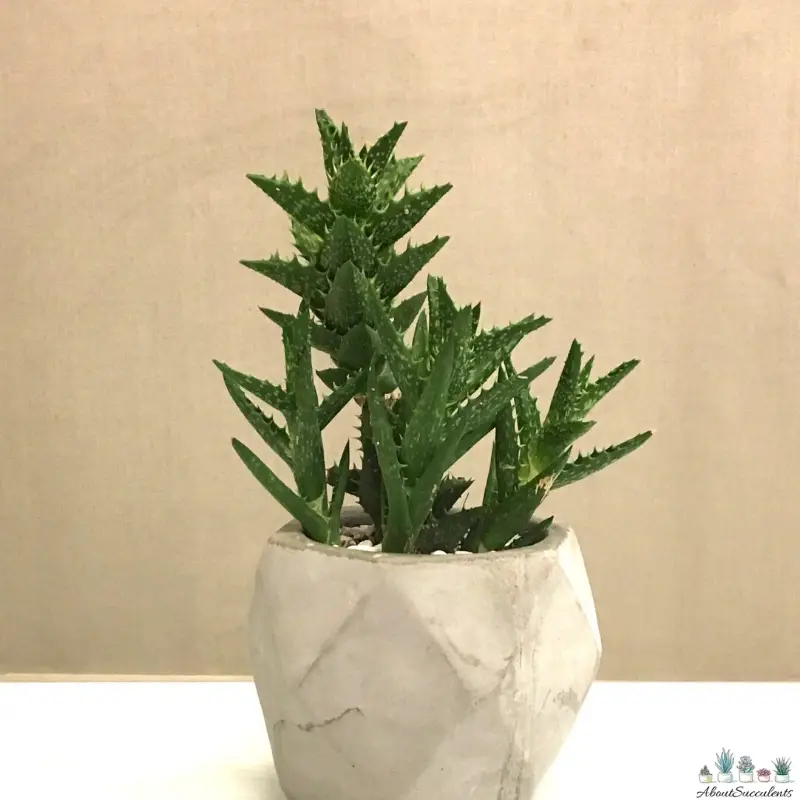
In the wintertime, the soil retains moisture much longer. You might give Aloe juvenna water only once a month.
3. Pot and Soil
Choose a pot that has a good-sized drain hole. Although Aloe juvenna may require more water than the typical succulent, it is still susceptible to root rot which happens if the plant receives too much water.
The pot should also be large enough to allow Tiger Tooth Aloe’s roots to grow properly without getting entangled.
You will also need well-draining soil. Good choices of soil for Aloe juvenna are sandy soil and cactus soil. To improve its drainage properties, add perlite. Use a 2:1 ratio of sandy/cactus to perlite.
How to Propagate Aloe Juvenna – Tiger Tooth Aloe
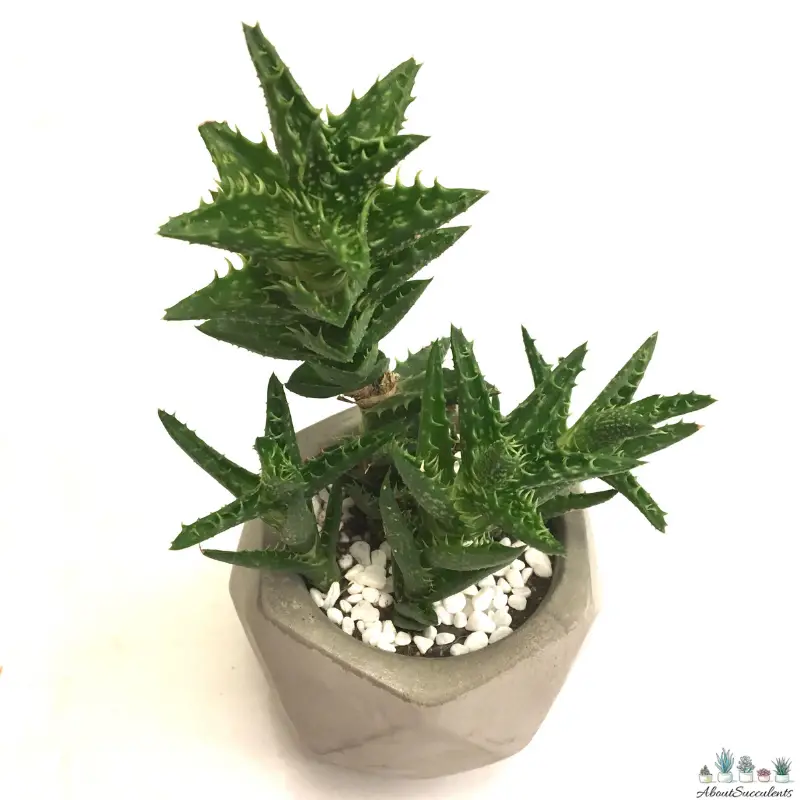
Aloe juvenna can only be propagated with offsets. The plant will produce a small number of rosette offsets.
You can try to propagate from seeds but the process will take too long.
Step 1 – Cut the offsets from the main stem of the plant by using a sharpened and sterilized knife or garden shears.
Step 2 – Leave the offsets in a dry and shaded area for 1 to 2 days or until it develops calluses.
Step 3 – Place the hardened offsets on well-draining soil.
Frequently Asked Questions
Is Aloe Juvenna Toxic for Cats and Dogs?
Aloe Juvenna does not appear in the list of plants that have been found to be toxic for cats and dogs. You can find the list on the website of the American Society for the Prevention of Cruelty to Animals (ASPCA).
Why is my Aloe Juvenna Succulent Dying?
If you suspect that your Aloe juvenna succulent is dying, there are 3 possible causes for this: Overwatering, underwatering, and sunburn.
1. Overwatering
When the leaves of Tiger Tooth Aloe turn yellow, that is a clear sign of overwatering. This means its roots are starting to rot.
It may not be because you have been giving it too much water. Quite possibly the soil has been staying moist longer than usual or that the type of soil is not drying out fast enough.
If this happens, remove the plant from its soil. Get a new pot and refill it with well-draining soil. Follow our earlier tip to mix sandy/cactus soil with perlite at a 2:1 ratio.
Remove the infected parts of the plant; its leaves, stem, and roots. Once it has dried out completely, re-pot it in fresh, new soil.
2. Underwatering
If the leaves of Tiger Tooth Aloe are starting to shrivel up, it means you are not giving it enough water.
The solution is to just give it more water and to check on the soil’s moisture level frequently. In 1-2 days, the leaves of Tiger Tooth Aloe should look healthy and green once again.
3. Sunburn
Did you move Aloe juvenna to a place that gets direct sun outdoors after having it grow indoors? If so, its leaves will get sunburned and turn brown.
The sunburn will leave permanent marks but you can remedy the situation simply by gradually exposing the plant to sunlight.
Start with partial shade and move to full sunlight once the plant has fully acclimated to outdoor conditions.
Does Aloe Juvenna Produce Flowers?
Yes, Aloe juvenna produces strikingly-beautiful flowers that have a bright orange color. Keep in mind that not all Tiger Tooth Aloes can bloom. It will depend on the conditions for growth. Ideally, the plant should receive enough sunlight.
Producing flowers requires energy. To support the best growing conditions for Aloe juvenna to bloom, it is recommended to give it fertilizer every 2 weeks during the growing season or the spring and summer months.
Use a fertilizer brand that is specially formulated for succulents and cacti. Reduce it to ¼ strength by diluting it with water before adding the fertilizer to the soil.
Last Updated on July 18, 2022 by Sofia Lara